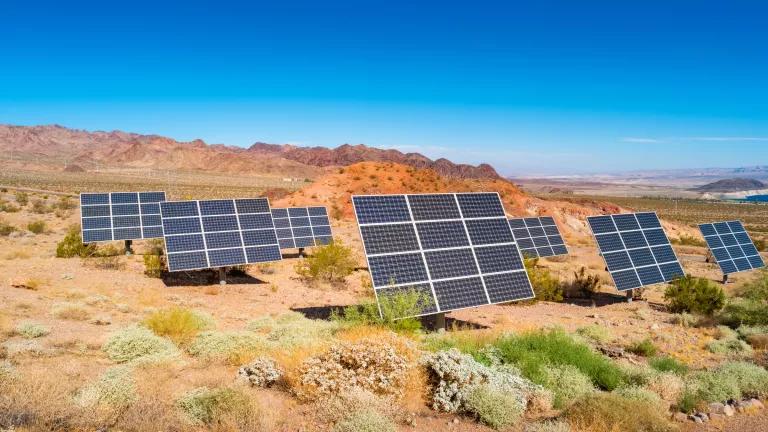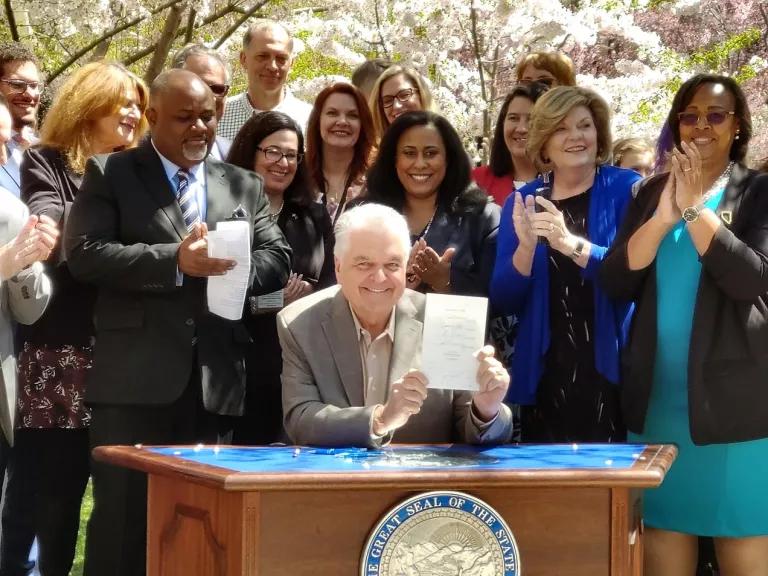2019 in Review: Nevada Steps Up on Clean Energy and Climate

Part of NRDC's Year-End Series Reviewing 2019 Energy & Climate Developments
This year was one of rapid progress for clean energy and climate commitments in Nevada. In fact, it may be the most impactful year Nevada has ever seen on these issues. With a new administration and the nation’s first female majority legislature, this year saw bills passed and signed on renewable energy standards, energy efficiency, electric transportation, and greenhouse gas reduction, as well as executive branch steps toward an inclusive transition to a low-carbon economy. The year also saw troubling reminders that the climate crisis is already here; accelerating our transition from fossil fuels to clean energy will support the state's air quality and public health.
In this blog, we’re highlighting some of the actions the state has taken to build a clean energy, low-carbon future that will foster healthy communities and a strong and diversified economy.
January
On January 16, Governor Steve Sisolak delivered his first State of the State, in which he declared that his administration would not spend a second debating the reality of climate change before taking action.
February
On February 4, the 80th session of the Nevada Legislature convened, with plenty of bills on clean energy, clean transportation, energy efficiency, and climate in the works. Democratic leadership in both chambers declared renewable energy standards, community solar, and conservation policies to be top priorities in the 2019 Nevada Blueprint.
March
On March 12, Governor Sisolak joined the U.S. Climate Alliance, a bipartisan group of governors committed to meeting the goals of the Paris Agreement. By joining the Alliance, Governor Sisolak pledged to implement policies to reduce greenhouse gas (GHG) emissions by 26-28 percent as compared to 2005 levels by 2025.
April
On Earth Day, Governor Sisolak signed a 50 percent renewable portfolio standard (RPS) sponsored by clean-energy champion Senator Chris Brooks. Thanks to SB 358, half of Nevada’s electricity will come from clean, renewable energy sources, like solar and wind, by 2030. The bill also sets a goal of 100 percent clean electricity by 2050. SB 358 passed with unanimous, bipartisan support in both chambers, showing legislators on both sides of the aisle understand the broad appeal and popularity of renewable energy across the state. For more on the clear advantages of clean energy for Nevada, read our blog on the RPS.

May
On May 23, Governor Sisolak signed a bill to promote all-electric school buses, which was co-sponsored by Senators Brooks and Pat Spearman and received nearly unanimous support in the legislature. SB 299 creates a pilot program where funds from an existing clean transportation program can be used to help school districts purchase electric school buses and gain experience using them. This will provide immediate health benefits to the children who rely on public buses—currently running on highly polluting diesel—to get to school every day. As electric bus prices fall and they make up a larger portion of school fleets, further electric transportation will help everyone who lives or works in the communities through which the current diesel school buses drive.
On May 27, Governor Sisolak signed a bill creating a backstop against the Trump administration’s attempt to stall federal light bulb efficiency standards. Introduced by the Nevada Governor’s Office of Energy (GOE), AB 54 ensures that Nevadans will maintain access to highly energy efficient light bulbs, even if Trump’s Department of Energy rolls back some or all of the current standard. These light bulb efficiency standards ensure wasteful, energy-guzzling bulbs won’t be sold in stores in the state—saving consumers money and keeping electricity demand from unnecessarily increasing.
June
On June 3, Governor Sisolak signed a greenhouse gas reduction bill sponsored by Senator Brooks into law. SB 254 puts into statute the 2025 climate goal that the governor committed to by joining the U.S. Climate Alliance and adds goals for 2030 (45 percent GHG reductions as compared to 2005 emissions) and 2050 (zero or near-zero emissions). This target setting is an important first step to avoid the worst impacts of climate change and safeguard Nevada’s human health, beautiful lands, quality of life, and economy.
July
On July 7, the Sisolak Administration signed on to the Nation’s Clean Car Promise, a coalition of 24 bipartisan governors in support of a strong national clean car standard that would reduce planet-warming and health-harming tailpipe emissions. As Bradley Crowell, the Director of the Department of Conservation and Natural Resources (DCNR) stated, the transportation sector is now the leading source of greenhouse gas emissions in the state.
August
In Las Vegas the average daily high this month reached an unpleasant and potentially deadly 106.7 degrees Fahrenheit—nearly 5 degrees higher than the historical normal—according to the National Weather Service. As the number and intensity of heat waves increase because of our climate crisis, compounded by the urban heat island effect, heat-related deaths are also increasing in cities like Vegas.
September
On September 19, the University of California, San Francisco and NRDC published the results of a study revealing the enormous toll of climate change on human health across the country, including Nevada. The study found that ozone air pollution led to 97 premature deaths, 114 hospital admissions, and $898 million in total health costs in the Silver State. Higher temperatures contribute to the formation of ground-level ozone, as do the chemicals spewing from the tailpipes of gas- and diesel-fueled cars and trucks.
On September 20, Nevada Attorney General Aaron D. Ford joined the multi-state lawsuit against the Trump Administration’s revocation of the Clean Air Act waiver that allows California and other states to set strong vehicle emission standards.
October
On October 15, the Clark County Board of Commissioners approved a resolution to join the County Climate Coalition, committing the state’s population center to meeting the environmental goals of the Paris Agreement.
November
On November 15, the Legislative Committee on Energy held its first meeting of the interim period. DCNR Director Crowell noted that the 50 percent RPS alone would not suffice to reach the state’s greenhouse gas emission reduction targets, while community leader Dr. Mary House advocated for more policies to support transportation electrification in the state.
On November 22, Governor Sisolak signed an executive order on climate, committing to reduce global-warming pollution in Nevada and work toward an equitable and inclusive transition to a carbon neutral, clean energy economy. Executive Order 2019-22 coordinates interagency development of policies to meet short-term and long-term greenhouse gas (GHG) reduction targets while gathering stakeholder and community input, considering the impact of climate policies on low-income and disadvantaged communities, and leading by example. For more details, read our blog on the climate executive order and why it’s needed.
In his remarks, Governor Sisolak recognized the importance of strong clean car standards in improving air quality and fighting climate change. We hope to see the state build on this acknowledgment by adopting the Advanced Clean Cars Program next year (more on that in our 2020 wish list).
December
On December 4, as part of the implementation of the strengthened RPS, the Public Utilities Commission of Nevada approved the development of three new utility-scale solar farms for the state’s largest utility, NV Energy. These projects will bring a total of 1,190 megawatts of new solar generation—enough to power 230,000 homes—and 590 megawatts of battery storage to the state by 2024. All located within 50 miles of Las Vegas, the Arrow Canyon Solar, Southern Bighorn Solar and Storage, and Gemini Solar and Storage projects will increase NV Energy’s renewable generation to 40 percent by 2025, double what it is today.
2020 Wish List
We’re excited about the steps to support climate action taken this year by Governor Sisolak and his administration, the State Legislature (especially bill sponsors like Senators Brooks and Spearman), and county and city officials. At the top of our wish list for 2020 are policies that will build on SB 299, Governor Sisolak joining the Nation’s Clean Car Promise, and AG Ford’s stance on states rights enshrined in the Clean Air Act—in other words, cutting pollution from transportation.
Governor Sisolak’s administration and state legislators should use the interim to adopt policies like the Advanced Clean Car Program in addition to policies that will increase public awareness about the benefits of electric cars to public health and the environment; expand electric car charging stations at homes, workplaces, and in public spaces; and clean up medium- and heavy-duty vehicles, like delivery trucks. Transportation emits more carbon than any other sector in Nevada. Ozone pollution and smog harm Nevadans today. The state needs to turn its attention to transportation now.
This blog was authored by Patricia Valderrama with input from Noah Long.



